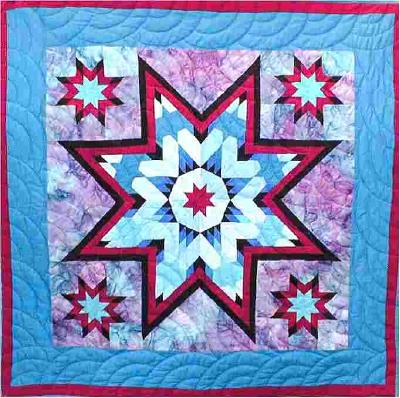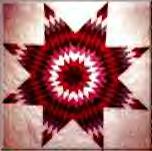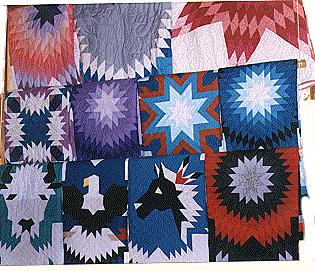|
|
Quilts Vital to Native American Traditions And that's just one example of how important quilts have become to Native American
societies in the 200 or so years since the art of quilting was introduced by European settlers. The increasing significance of quilts to the social fabric of Native Americans is explored
in "To Honor and Comfort: Native Quilting Traditions," an exhibition of 45 Native American quilts currently
showing at the Museum of International Folk Art in Santa Fe. The exhibit was brought to Santa Fe by the Smithsonian
Institution Traveling Exhibition Service. Quilts are an underrated form of cultural expression for Native American tribes, says
exhibit curator Marsha MacDowell, a professor of art history at Michigan State University and a curator of folk
art at the Michigan State University Museum. "To most scholars, it still had a taint of being European and most didn't think
it worthy of study. Certainly the art market hasn't seized on it." MacDowell has found in her research that quilts are used in virtually every Native
American society. The Hopi, like many other tribes, give newly named babies quilts as gifts. Many tribes
honor veterans with gifts of quilts in red, white and blue. At the annual high school basketball tournament, a ceremony is held during which students
give homemade quilts to people they admire. "Very often you'll see a basketball in the middle of the quilt or in the corners,
along with war bonnets and eagles," said MacDowell. MacDowell and her husband, Michigan State English professor Kurt Dewhurst, curated
the exhibit with the help of Michigan State and the National Museum of the American Indian. The couple also wrote a companion book of the same name that is available at the Folk
Art Museum and features illustrations of quilts, essays on contemporary and historical quilting traditions, images
and meanings and profiles of quilters from across the country. After all her research, MacDowell guesses that quilts are popular among Native Americans
for the same reason they are popular for society at large. "They serve the pretty basic function of keeping people warm and being soft to
sit on. When they are handmade and given as gifts, they demonstrate a real human spirit of giving of oneself." If you go:
Call (505) 827-6463 for information Native American
Quilting Traditions
by Tracy Dingmann, Staff Writer The Albuquerque Journal
 For
some Plains Indians, handmade quilts have replaced buffalo robes in all-important tribal baby-naming ceremonies.
The practice of standing on a buffalo robe during the baby-naming ceremony has given way to standing on a Morning
Star quilt, an elaborately colored composition of an eight-point star.
For
some Plains Indians, handmade quilts have replaced buffalo robes in all-important tribal baby-naming ceremonies.
The practice of standing on a buffalo robe during the baby-naming ceremony has given way to standing on a Morning
Star quilt, an elaborately colored composition of an eight-point star. "One
of the things I found surprising was how little the academic community knows of quilt-making in Native America,"
said MacDowell. "It was introduced as a European art, yet it quickly became an art form that Native people
imbued with Native colors, symbols and meaning.
"One
of the things I found surprising was how little the academic community knows of quilt-making in Native America,"
said MacDowell. "It was introduced as a European art, yet it quickly became an art form that Native people
imbued with Native colors, symbols and meaning. To show
how quilts have been co-opted into contemporary society, a portion of the exhibit deals with an annual ceremony
among the Sioux and Assiniboine Indians of Brockton, Mont.
To show
how quilts have been co-opted into contemporary society, a portion of the exhibit deals with an annual ceremony
among the Sioux and Assiniboine Indians of Brockton, Mont.
WHAT:
"To Honor and Comfort: Native Quilting Traditions"
WHEN:
Open now through Dec. 31. Hours are 10 a.m.-5 p.m. Tuesdays through Sundays
WHERE:
Museum of International Folk Art in Santa Fe
HOW MUCH:
Museum admission is $1 on Sundays for New Mexico residents with ID, otherwise, $5 for
adults and free for ages 16 and younger.
http://www.richmond.edu/~ed344/webquests/quilts/nativeamerican.html
Native American Quilts
http://womenfolk.com/grandmothers/natam.htm
![]()
|
|
| Canku Ota is a free Newsletter celebrating Native America, its traditions and accomplishments . We do not provide subscriber or visitor names to anyone. Some articles presented in Canku Ota may contain copyright material. We have received appropriate permissions for republishing any articles. Material appearing here is distributed without profit or monetary gain to those who have expressed an interest. This is in accordance with Title 17 U.S.C. section 107. |
|
Canku Ota is a copyright of Vicki Lockard and Paul Barry. |
|